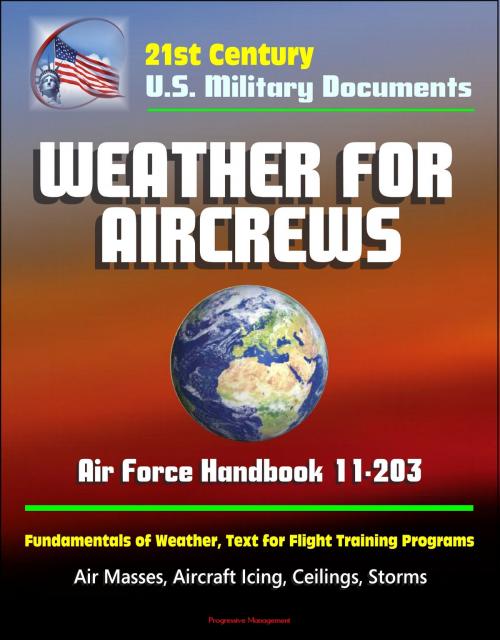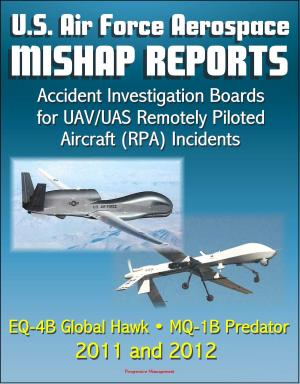21st Century U.S. Military Documents: Weather for Aircrews - Air Force Handbook 11-203, Fundamentals of Weather, Text for Flight Training Programs, Air Masses, Aircraft Icing, Ceilings, Storms
Nonfiction, Social & Cultural Studies, Social Science, Archaeology, History, Military, Aviation| Author: | Progressive Management | ISBN: | 9781311042835 |
| Publisher: | Progressive Management | Publication: | November 13, 2013 |
| Imprint: | Smashwords Edition | Language: | English |
| Author: | Progressive Management |
| ISBN: | 9781311042835 |
| Publisher: | Progressive Management |
| Publication: | November 13, 2013 |
| Imprint: | Smashwords Edition |
| Language: | English |
This handbook familiarizes the aircrew member with fundamentals of weather. It serves as a text for flight training programs, all USAF instrument refresher training, flight instruction programs, and various unit and individual flying training programs. It is issued to each instructor and student involved in undergraduate flight training programs as well as to each flying unit. This handbook, when used with related flight directives and publications, provides weather guidance for visual and instrument flight under most circumstances. It is not a substitute for sound judgment.
Chapter 1 * THE EARTH'S ATMOSPHERE * 1.1. Introduction * 1.2. Composition of the Atmosphere * 1.3. The Troposphere * 1.4. Aircrew Environment * Chapter 2 * MOISTURE * 2.1. Introduction * 2.2. Changes of State * 2.3. Relative Humidity * 2.4. Dew Point, Dew and Frost * 2.5. Condensation and Evaporation * 2.6. Clouds and Fog * 2.7. Precipitation * Chapter 3 * TEMPERATURE * 3.1. Introduction * 3.2. Measuring Temperature * 3.3. Temperature Scales * 3.4. Diurnal Cycle * 3.5. Land/Sea Difference * 3.6. Lapse Rate * 3.7. Inversions * Chapter 4 * ATMOSPHERIC PRESSURE AND ALTIMETRY * 4.1. Introduction * 4.2. Atmospheric Pressure * 4.3. Pressure Distribution * 4.4. Pressure Correction * 4.5. Temperature Effects on Pressure * 4.6. Pressure Maps * 4.7. Standard Atmosphere * 4.8. Pressure Altitude * 4.9. Density Altitude * Chapter 5 * WIND * 5.1. Introduction * 5.2. Causes of Wind * 5.3. Jet Streams * 5.4. Circulation Patterns * 5.5. Cyclones and Anticyclone (Highs and Lows) * 5.6. Local Effects Winds * 5.7. Valley Wind and Mountain Breeze * 5.8. Katabatic Winds * 5.9. Upslope Winds * 5.10. Down-slope Winds * Chapter 6 * CLOUDS * 6.1. Introduction * 6.2. Cloud Composition * 6.3. Cloud Families * 6.4. Low Clouds * 6.5. Middle Clouds * 6.6. High Clouds * 6.7. Clouds With Extensive Vertical Development * 6.8. Other Clouds * Chapter 7 * AIR MASSES * 7.1. Understanding of Air Masses * 7.2. Air Mass Types * 7.3. Air Mass Modification * 7.4. Air Mass Modification by Terrain * 7.5. Air Mass Stability * Chapter 8 * FRONTS * 8.1. Introduction * 8.2. Fronts * 8.3. Types of Fronts * 8.4. Identifying a Front * 8.5. Frontal Passage * 8.6. Cold Front * 8.7. Squall Lines * 8.8. Warm Front * 8.9. Stationary Front * 8.10. Frontal Waves * 8.11. Occlusions * Chapter 9 * TURBULENCE * 9.1. Introduction * 9.2. Turbulence Causes * 9.3. Categories of Turbulence * 9.4. Causes of Turbulence * 9.5. Effects on Aircraft * 9.6. Convective Turbulence * 9.7. Mechanical Turbulence * 9.8. Terrain Turbulence * 9.9. Mountain Wave Turbulence * 9.10. Clear Air Turbulence (CAT) * 9.11. Jet Streams and CAT * 9.12. Polar Front Jet (PFJ) Stream * 9.13. Aircrew Notes * 9.14. Low-Level Jet Stream * 9.15. Wake Turbulence * Chapter 10 * WINDSHEAR * 10.1. Introduction * 10.2. Windshear definition * 10.3. Performance Decreasing Shear * 10.4. Microburst * 10.5. Low Level Windshear (LLWS) * 10.6. Frontal Shear * 10.7. Local Winds * 10.8. Land/Sea Breeze Shear * 10.9. Windshear Lessons Learned * 10.10. Stick Shaker * 10.11. Windshear Detection Systems * Chapter 11 * AIRCRAFT ICING * 11.1. Introduction * 11.2. Groups of Icing * 11.3. Structural Icing * 11.4. Types of Icing * 11.5. Icing Amounts * 11.6. Icing Dangers. * 11.7. Helicopter Icing * 11.8. Engine Icing * 11.9. Carburetor Icing * 11.10. Induction Icing * 11.11. Inlet Guide Vane Icing * 11.12. Weather Conditions for Icing * Chapter 12 * VISIBILITY AND CEILINGS
This handbook familiarizes the aircrew member with fundamentals of weather. It serves as a text for flight training programs, all USAF instrument refresher training, flight instruction programs, and various unit and individual flying training programs. It is issued to each instructor and student involved in undergraduate flight training programs as well as to each flying unit. This handbook, when used with related flight directives and publications, provides weather guidance for visual and instrument flight under most circumstances. It is not a substitute for sound judgment.
Chapter 1 * THE EARTH'S ATMOSPHERE * 1.1. Introduction * 1.2. Composition of the Atmosphere * 1.3. The Troposphere * 1.4. Aircrew Environment * Chapter 2 * MOISTURE * 2.1. Introduction * 2.2. Changes of State * 2.3. Relative Humidity * 2.4. Dew Point, Dew and Frost * 2.5. Condensation and Evaporation * 2.6. Clouds and Fog * 2.7. Precipitation * Chapter 3 * TEMPERATURE * 3.1. Introduction * 3.2. Measuring Temperature * 3.3. Temperature Scales * 3.4. Diurnal Cycle * 3.5. Land/Sea Difference * 3.6. Lapse Rate * 3.7. Inversions * Chapter 4 * ATMOSPHERIC PRESSURE AND ALTIMETRY * 4.1. Introduction * 4.2. Atmospheric Pressure * 4.3. Pressure Distribution * 4.4. Pressure Correction * 4.5. Temperature Effects on Pressure * 4.6. Pressure Maps * 4.7. Standard Atmosphere * 4.8. Pressure Altitude * 4.9. Density Altitude * Chapter 5 * WIND * 5.1. Introduction * 5.2. Causes of Wind * 5.3. Jet Streams * 5.4. Circulation Patterns * 5.5. Cyclones and Anticyclone (Highs and Lows) * 5.6. Local Effects Winds * 5.7. Valley Wind and Mountain Breeze * 5.8. Katabatic Winds * 5.9. Upslope Winds * 5.10. Down-slope Winds * Chapter 6 * CLOUDS * 6.1. Introduction * 6.2. Cloud Composition * 6.3. Cloud Families * 6.4. Low Clouds * 6.5. Middle Clouds * 6.6. High Clouds * 6.7. Clouds With Extensive Vertical Development * 6.8. Other Clouds * Chapter 7 * AIR MASSES * 7.1. Understanding of Air Masses * 7.2. Air Mass Types * 7.3. Air Mass Modification * 7.4. Air Mass Modification by Terrain * 7.5. Air Mass Stability * Chapter 8 * FRONTS * 8.1. Introduction * 8.2. Fronts * 8.3. Types of Fronts * 8.4. Identifying a Front * 8.5. Frontal Passage * 8.6. Cold Front * 8.7. Squall Lines * 8.8. Warm Front * 8.9. Stationary Front * 8.10. Frontal Waves * 8.11. Occlusions * Chapter 9 * TURBULENCE * 9.1. Introduction * 9.2. Turbulence Causes * 9.3. Categories of Turbulence * 9.4. Causes of Turbulence * 9.5. Effects on Aircraft * 9.6. Convective Turbulence * 9.7. Mechanical Turbulence * 9.8. Terrain Turbulence * 9.9. Mountain Wave Turbulence * 9.10. Clear Air Turbulence (CAT) * 9.11. Jet Streams and CAT * 9.12. Polar Front Jet (PFJ) Stream * 9.13. Aircrew Notes * 9.14. Low-Level Jet Stream * 9.15. Wake Turbulence * Chapter 10 * WINDSHEAR * 10.1. Introduction * 10.2. Windshear definition * 10.3. Performance Decreasing Shear * 10.4. Microburst * 10.5. Low Level Windshear (LLWS) * 10.6. Frontal Shear * 10.7. Local Winds * 10.8. Land/Sea Breeze Shear * 10.9. Windshear Lessons Learned * 10.10. Stick Shaker * 10.11. Windshear Detection Systems * Chapter 11 * AIRCRAFT ICING * 11.1. Introduction * 11.2. Groups of Icing * 11.3. Structural Icing * 11.4. Types of Icing * 11.5. Icing Amounts * 11.6. Icing Dangers. * 11.7. Helicopter Icing * 11.8. Engine Icing * 11.9. Carburetor Icing * 11.10. Induction Icing * 11.11. Inlet Guide Vane Icing * 11.12. Weather Conditions for Icing * Chapter 12 * VISIBILITY AND CEILINGS















